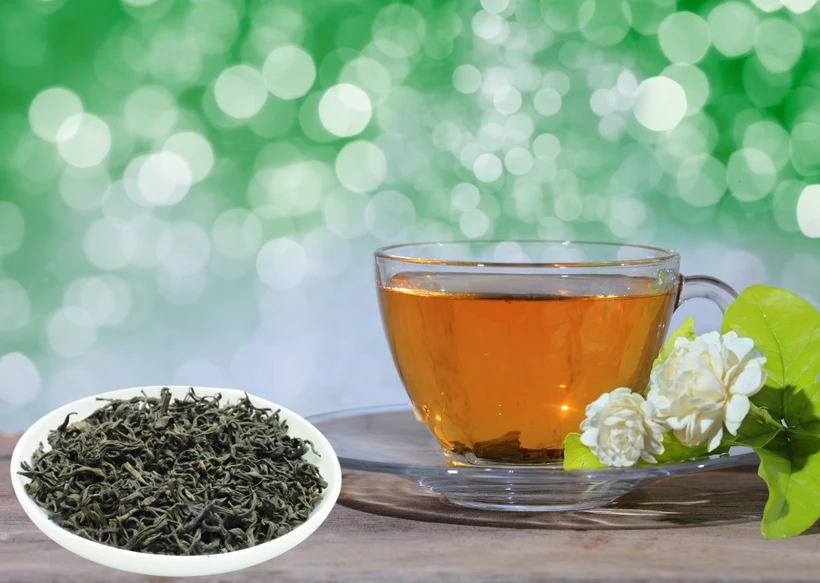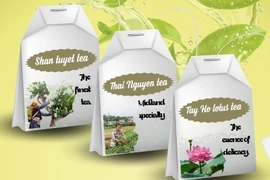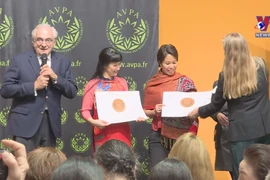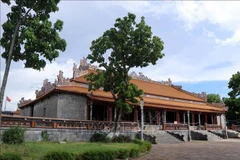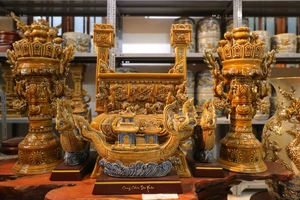Hanoi (VNA) – Vietnam's tea culture unfurls like a lotus blossom, delicate yet resilient, deeply rooted in history and cherished in the daily lives of its people.
The art of Vietnamese tea, from processing and brewing to savoring, is a dance of elegance and subtlety, engaging all five senses and fostering meaningful conversations.
Vietnamese tea is divided into three main types: fresh, dried and scented. Among them, scented tea is particularly special, created through a delicate infusion of tea leaves with natural floral aromas.
Lotus-scented tea – pinnacle of perfection
Lotus-scented tea is considered the pinnacle of Vietnam’s scented teas, with Tay Ho lotus tea revered as a "treasured gem" of Hanoi. It has been listed on the National Intangible Cultural Heritage list.

Dubbed the "Thien co de nhat tra" (timeless best tea), Tay Ho lotus tea is a perfect harmony of the delicate bitterness and sweetness of green tea combined with the pure, elegant fragrance of Bach Diep lotus, a rare and exquisite variety native to Quang An, the cradle of the traditional lotus tea-making craft.
The creation of Tay Ho lotus tea is a labour of love, requiring meticulous preparation. Fresh lotus-infused tea involves stuffing premium tea into lotus buds and allowing the tea to absorb the fragrance overnight. Dried lotus tea undergoes a 21-day scenting and drying process, using the tiny white granules (gao sen) extracted from lotus stamens. The result is a top-tier tea with unparalleled aroma, taste, and health benefits, from boosting immunity, reducing stress and anxiety and lowering the risk of cardiovascular disease.
Jasmine-scented tea – A traditional flavour
A global favorite, jasmine tea is one of Vietnam's three traditional scented teas. Its gentle fragrance offers respite from stress and anxiety, boosts energy after long hours of work, and supports digestive health.
The Vietnamese jasmine tea comes in three main varieties, namely ancient tree jasmine tea, fishhook-style green tea with jasmine, and Oolong jasmine tea.
Chrysanthemum-scented tea – A fragrance of nostalgia
Evocative of Vietnam's Lunar New Year (Tet), chrysanthemum-scented tea is a fragrant reminder of home and tradition.

Chrysanthemum is also a precious medicinal herb, known for its calming effects, ability to clear heat, detoxify, fight oxidative stress, combat bacteria, prevent cancer, regulate the immune system, and protect the liver.
The process of scenting tea with chrysanthemums is simpler than with other flowers. The scenting process involves drying chrysanthemum flowers and combining them with tea. The mixture is then lightly roasted over medium heat. Later, the tea is allowed to rest in a sealed container for 3-5 days before the flowers are separated from the tea, resulting in the final product.
Ngau flower-scented Tea – A unique delicacy of Vietnam
Ngau flower-scented tea is exclusive to Vietnam, with no widespread equivalent found in other countries.
The ngau flower, a small white blossom, has been traditionally planted in Vietnamese gardens and is still commonly grown today as an ornamental or feng shui plant.

To prepare ngau flower tea, the flowers are dried over the course of about a week. Once dried, they are layered with tea leaves, alternating between a layer of tea and a layer of ngau flowers. After being left to steep for 2-3 days, the flowers are sifted out, and the tea is ready for use.
Both the tea and the ngau flowers are known for their health benefits, particularly in reducing blood fat and lowering blood pressure. This combination not only provides a delicate flavour but also offers medicinal properties that are good for overall health.
Soi flower-scented tea – pure and gentle
To prepare soi flower-scented tea, the flowers are harvested early in the morning and immediately layered with tea leaves before the flowers begin to wilt and lose their fragrance. The flowers are used in a ratio of 300-400 grams per kg of tea.

The process begins by placing a layer of tea, followed by a layer of soi flowers, and repeating this pattern until all the tea has been scented, with a final layer of tea on top. The mixture is then left to infuse for 2-3 days, either sun-dried or gently roasted, allowing the tea to absorb the essential oils released by the flowers.
The fragrance of soi flower tea offers a sense of peace and elegance. Additionally, soi flowers are valued for their medicinal properties, especially in reducing inflammation. Combined with the antioxidant benefits of tea, this makes for a detoxifying, body-purifying drink that is also beneficial for heart health and joint function.
Osmanthus flower-scented tea – sweet enchantment
To scent just 300 grams of tea, 9 kg of fresh osmanthus are needed. The flowers are gently spread over the tea and mixed carefully, after which the mixture is left to steep in a jar and buried underground for three days. Once the steeping process is complete, the tea is roasted, with careful attention paid to maintaining the right temperature to allow the tea to absorb the floral aroma.

The finished osmanthus-scented tea, when brewed, carries the sweet, fruity fragrance. A sip reveals a delicate, smooth bitterness, intertwined with the sweet, floral notes that linger in the mouth.
Osmanthus-scented tea is also highly beneficial for health, promoting blood circulation and regulating blood pressure./.
